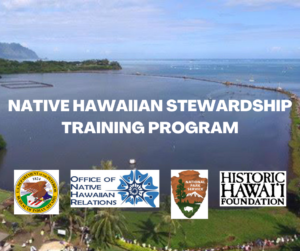 Historic Hawai‘i Foundation’s new initiative to partner with Native Hawaiian Organizations (NHO) on hands-on stewardship training for historic and cultural properties has reached a significant milestone with selection of the first cohort of partners.
Historic Hawai‘i Foundation’s new initiative to partner with Native Hawaiian Organizations (NHO) on hands-on stewardship training for historic and cultural properties has reached a significant milestone with selection of the first cohort of partners.
HHF established the stewardship training program in 2021 through a partnership with the U.S. Department of the Interior’s National Park Service and Office of Native Hawaiian Relations, with funding through the Bureau of Indian Affairs. Additional funding is provided by the Hawai‘i Tourism Authority through a Kūkulu Ola grant for Native Hawaiian culture.
The program objectives are to build capacity of NHOs towards historic preservation and stewardship with the goal of ensuring that their traditional cultural stories and places are being documented, preserved and shared in an appropriate manner with visitors and residents alike.
“Starting up a new program, especially with federal funds and partners, has to be done systematically and deliberately,” said Kiersten Faulkner, executive director of Historic Hawai‘i Foundation. “We started with listening sessions to get a sense of the sites, the preservation needs and the landscape of NHOs working in cultural stewardship. That informed our decision to have a two-step selection process, first with an open Request for Expressions of Interest, followed by an invitation-only Request for Proposal.”
Both the Expressions of Interest and the Proposals were evaluated and ranked by a program committee of HHF Trustees. Committee members include Maenette Ah Nee Benham, Allen Hoe, Donne Dawson, Lehua Kauhane and Kawika McKeague as well as ONHR staff members Stanton Enomoto and Lisa Oshiro Suganuma and NPS director of preservation partnerships Elaine Jackson-Retondo.
“We had submittals from every island and for all types of historic and cultural properties, including sacred sites like heiau, places associated with food-ways like fishponds and field systems, and places for cultural practice and gathering.”
“Through this process, we have a rank ordered list of NHO partners. We’ll work with the highest ranked organizations to develop a written agreement on the activities that will accomplished and that will meet the program objectives,” Faulkner said. “The implementation should follow shortly afterward. Most of the programs are anticipated to run over the course of 12-18 months.”
Faulkner said that the committee praised the diligence, commitment and expertise of the project proponents. “We had submittals from every island and for all types of historic and cultural properties, including sacred sites like heiau, places associated with food-ways like fishponds and field systems, and places for cultural practice and gathering,” she said. “The committee said that the proposals really demonstrate the importance of these places and people who are caring for them. The selection was challenging because all of them were so good but we didn’t have the resources to fund everyone this round.”
The project teams will evaluate both the model for the program and the individual outcomes for the selected partners to revise and update the process before opening a new round of proposals, with a projected cycle to be held in 2024.
This article was originally published in the July 2022 issue of Historic Hawai‘i News, the Foundation’s membership newsletter. To join our preservation ‘ohana and receive your own subscription to the newsletter, please visit this link.

